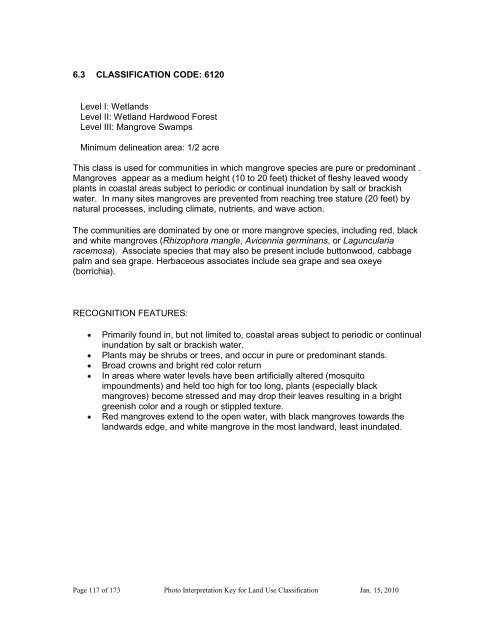Photo Interpretation Key - Southwest Florida Water Management ...
Photo Interpretation Key - Southwest Florida Water Management ...
Photo Interpretation Key - Southwest Florida Water Management ...
You also want an ePaper? Increase the reach of your titles
YUMPU automatically turns print PDFs into web optimized ePapers that Google loves.
6.3 CLASSIFICATION CODE: 6120<br />
Level I: Wetlands<br />
Level II: Wetland Hardwood Forest<br />
Level III: Mangrove Swamps<br />
Minimum delineation area: 1/2 acre<br />
This class is used for communities in which mangrove species are pure or predominant .<br />
Mangroves appear as a medium height (10 to 20 feet) thicket of fleshy leaved woody<br />
plants in coastal areas subject to periodic or continual inundation by salt or brackish<br />
water. In many sites mangroves are prevented from reaching tree stature (20 feet) by<br />
natural processes, including climate, nutrients, and wave action.<br />
The communities are dominated by one or more mangrove species, including red, black<br />
and white mangroves (Rhizophora mangle, Avicennia germinans, or Laguncularia<br />
racemosa). Associate species that may also be present include buttonwood, cabbage<br />
palm and sea grape. Herbaceous associates include sea grape and sea oxeye<br />
(borrichia).<br />
RECOGNITION FEATURES:<br />
Primarily found in, but not limited to, coastal areas subject to periodic or continual<br />
inundation by salt or brackish water.<br />
Plants may be shrubs or trees, and occur in pure or predominant stands.<br />
Broad crowns and bright red color return<br />
In areas where water levels have been artificially altered (mosquito<br />
impoundments) and held too high for too long, plants (especially black<br />
mangroves) become stressed and may drop their leaves resulting in a bright<br />
greenish color and a rough or stippled texture.<br />
Red mangroves extend to the open water, with black mangroves towards the<br />
landwards edge, and white mangrove in the most landward, least inundated.<br />
Page 117 of 173 <strong>Photo</strong> <strong>Interpretation</strong> <strong>Key</strong> for Land Use Classification Jan. 15, 2010
















